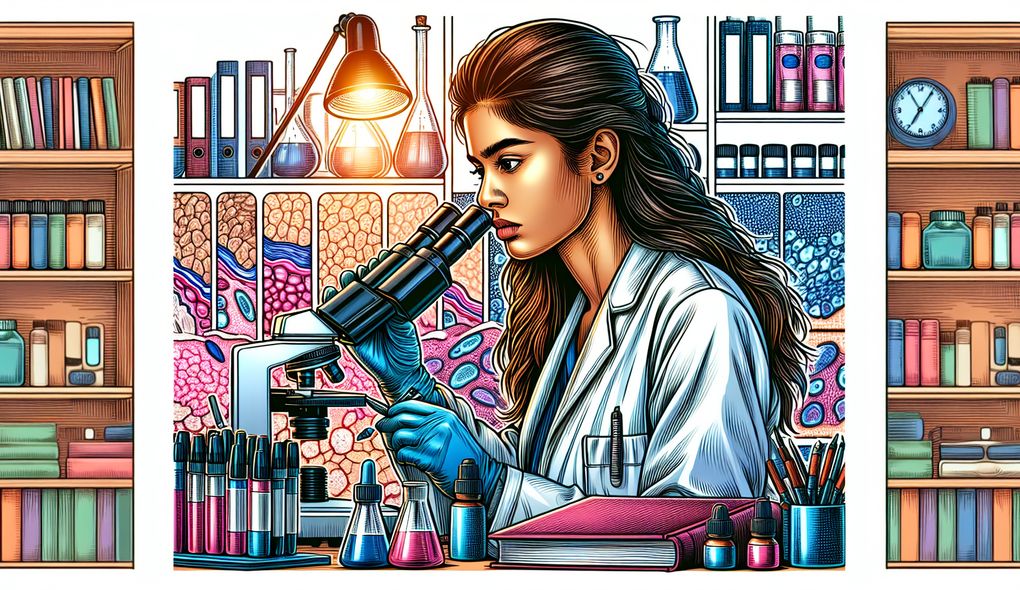Can you explain the process of correlating clinical information with histopathological findings?
JUNIOR LEVEL

Sample answer to the question:
Correlating clinical information with histopathological findings is a crucial part of the dermatopathology process. It involves analyzing patient data, such as medical history, symptoms, and physical examinations, and comparing it with the microscopic examination of skin tissue samples. By doing this, we can determine the correlation between the clinical presentation and the histopathological changes observed under the microscope. This correlation helps in providing accurate diagnoses and effective treatment plans for patients.
Here is a more solid answer:
The process of correlating clinical information with histopathological findings requires a multi-step approach. Firstly, I carefully review the patient's medical history, noting any relevant symptoms, previous treatments, and family history. Next, I collaborate with dermatologists to gather additional clinical information, such as physical examinations and imaging results. Once we have a comprehensive understanding of the patient's clinical presentation, I perform a microscopic examination of the skin tissue samples. Using high-resolution microscopes and laboratory diagnostic equipment, I analyze the cellular and tissue changes present. By comparing these histopathological findings with the clinical information, I can make an accurate diagnosis and provide specific treatment recommendations for the patient. Throughout this process, attention to detail is critical to ensuring accurate correlations and avoiding any misinterpretations. Effective communication with dermatologists is also essential to fully understand the clinical context and collaborate effectively in offering comprehensive patient care.
Why is this a more solid answer?
The solid answer expands on the basic answer by providing specific steps and examples of the process. It also highlights the use of laboratory diagnostic equipment, the importance of attention to detail, and emphasizes the collaboration with dermatologists. However, it could further improve by mentioning the use of laboratory information systems (LIS) and the commitment to continued medical education and professional development.
An example of a exceptional answer:
Correlating clinical information with histopathological findings is a meticulous process that requires a thorough understanding of both disciplines. As a dermatopathologist, I approach this process by first conducting a comprehensive review of the patient's medical history, paying close attention to relevant clinical details, medications, and prior treatments. I then collaborate closely with dermatologists, discussing the patient's symptoms, physical examinations, and any additional diagnostic tests performed, such as biopsies or imaging studies. Armed with this information, I proceed to meticulously examine the skin tissue samples under a microscope, utilizing cutting-edge laboratory diagnostic equipment and techniques. I carefully analyze the cellular morphology, tissue architecture, and any specific staining patterns to identify the histopathological changes. As crucial as microscopy is, I am also aware of the importance of integrating other ancillary studies, such as immunohistochemistry or molecular analysis, to further enhance our diagnostic accuracy. By combining the clinical information and the histopathological findings, I am able to provide dermatologists with a comprehensive interpretation of the patient's condition and offer tailored treatment recommendations. To stay updated and maintain my diagnostic expertise, I actively participate in continuous medical education programs, attend conferences, and engage in collaborative research. This allows me to stay at the forefront of dermatopathology advancements and ensure the highest quality of patient care.
Why is this an exceptional answer?
The exceptional answer provides a detailed and comprehensive explanation of the process, including specific techniques and additional ancillary studies. It also emphasizes the integration of clinical and histopathological information, extends the discussion to molecular analysis and immunohistochemistry, and highlights the commitment to continued medical education and professional development. The answer demonstrates a deep understanding of the role of a dermatopathologist and showcases the candidate's expertise.
How to prepare for this question:
- Familiarize yourself with the basic principles of dermatopathology and the correlation of clinical information with histopathological findings.
- Review cases and studies related to dermatopathology to gain a better understanding of real-world scenarios.
- Stay updated with the latest advancements in dermatopathology through medical literature, conferences, and online resources.
- Improve your diagnostic skills by practicing with slide-based examinations and participating in case discussions with experienced dermatopathologists.
- Develop strong communication skills to effectively collaborate with dermatologists and other healthcare professionals.
What are interviewers evaluating with this question?
- Clinical information analysis
- Histopathological findings correlation
- Diagnostic expertise
- Collaboration with dermatologists
- Patient care

